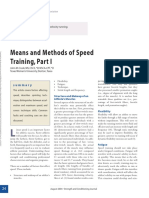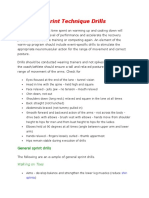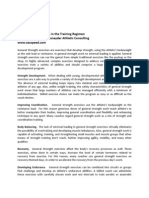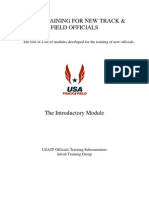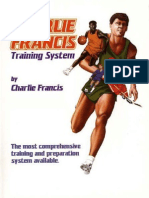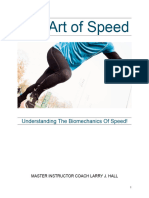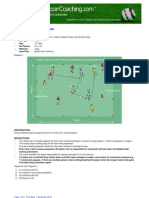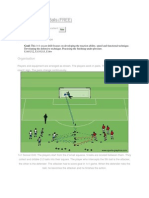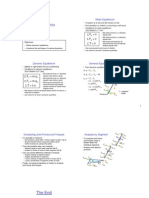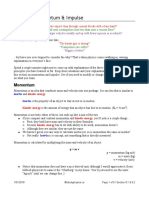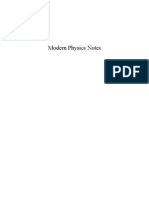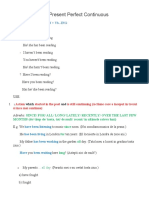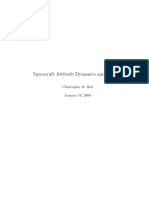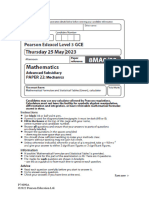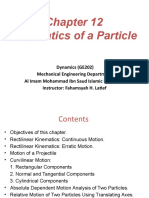Biomechanical Principles in Sprint Running
Basic Concepts Iain Fletcher
�Content
Stride Length Stride Frequency Newtons Laws Running Mechanics How to Run Faster!!
�Asafa Powell 9.77s
�Running Speed
Stride length x stride frequency At faster running speeds (above 7ms-1) stride frequency increases more then stride length
Up to 2.6m stride length & 5Hz frequency
Force production increased with running speed
Up to 4.6 x body weight NB 5.5 x body weight for a heel striker at 9.5m s-1
Max speed ground contact 0.08- 0.1sec Mero et al. (1992)
� increase in stride length, stride frequency, force production or decrease in ground contact will increase speed What is your training designed to change?
�Newtons 2nd Law of Motion
Momentum Law of acceleration Rate of change of momentum of an object (acceleration) is proportional to the force causing it & takes place in the direction in which the force acts = mass x velocity (mv) Remember F =ma
So acceleration can be worked out from a known force quite easily (a=F/m)
�Impulse
Linked to Newtons 2nd Law Force x time applied = impulse to an object r= 0.74 between propulsive force & running velocity in 1st contact after the blocks (Mero et al., 1992)
�Impulse- Momentum Relationship
Need to exert a force to cause a change in velocity Direction of force causes direction of acceleration Increase force increases momentum Or more precise increase impulse increases momentum
�Newtons 3rd Law of Motion
For every action (force) exerted by 1 object on a 2nd, there is an equal & opposite reaction (force) exerted by the 2nd object on the 1st
e.g. ground reaction force
�Sprint Components
Speed = stride length x stride frequency
2m/stride x 4 strides/s = 8ms-1
Increase in either component should not negatively effect the other
�Stride Length
Sum of Takeoff distance
Horizontal distance that C of G is forward of the take off foot at the instant the latter leaves the ground
Flight distance
Horizontal distance that the C of G travels while the runner is in the air
Landing distance
Horizontal distance that the toe of the lead foot is forward of the C of G at the instant sprinter lands
�Stride Length
�Landing Distance (Support Phase)
Smallest of 3 contributions to total stride length Arrests athletes downward motion (acceleration due to gravity plus active descent leg)
Triple flexion to absorb force Prepare for driving phase
� Need as favourable ground reaction forces as possible
Increasing landing distance can increase breaking force so decrease running speed as stride frequency decreases Foot position under the C of G travelling backwards Breaking phase less in faster sprinters (Mero et al., 1992)
�How to Limit Breaking Force?
Athlete in flight phase C of G moving forward with a horizontal velocity determined the moment the athlete left the ground
C of G moving at 10 ms-1 lead legs foot moving forward at 2 ms-1 Landing foot velocity = 12 ms-1 Direction foot travelling will alter or maintain athletes motion pawing action on ground contact, but problems with hamstring stress
�Foot Position
Importance of dorsi flexed ankle
Store strain energy from stretch and recoil of calf complex (achilles tendon) Pre stretch of calf complex helps promote Stretch Shortening Cycle Decrease coupling time between eccentric and concentric contraction Store mechanical work as elastic energy during eccentric phase (Biewener & Roberts, 2000) Peak Achilles tendon force (12-13 x body wt.)
�Tension-Length Relationship
Muscle Tension Contraction Range in vivo
Sum Passive
Active Component
50
100 Length (% resting length)
150
�Force-Velocity Relationship
� Muscles, tendons & ligaments behave like a spring
Higher stride frequencies associated with increased spring (MTU) stiffness (Farley & Gonzalez, 1996) EMG in GA starts 100ms before ground contact helps increase MTU stiffness (Mero & Komi, 1987)
�Takeoff Distance (Driving Phase)
Drive down and backwards through forceful extension of the hip, knee and ankles kinetic chain
Projects body upwards & forwards
Importance of full extension to provide greater impulse maximising forward momentum Peak power generated proximal to distal sequence
�Stride Frequency
Combination of ground contact time and flight phase time Ratio between the 2
2:1 during the start 1:1.3/ 1:1.5 at max speed (Housden, 1964) Start 67% ground contact Top speed 40-45% ground contact (Atwater, 1981)
� Time athlete in contact with ground governed primarily
Take off velocity from previous stride By the speed of the foot of the support leg Driving body forward and upward into next flight phase
� Faster sprinters extend hip further (Kunz & Kaufmann, 1981)
Increase time force applied Increase impulse
Short ground contacts in elite sprinting
Result of high forward speeds not the cause of them So body travels past foot very quickly v=d/t Time = distance/velocity (t=d/v)
�Hip Extension
��Braking and Propulsive Impulse
�Vertical vs Horizontal force dominance
Vertical Vertical
Horizontal Horizontal
Time Time
�Flight Phase (Recovery Phase)
During flight phase body determined by projectile motion
Release velocity Angle of take off Height of release Air resistance
Most important velocity of release
Determined by the ground reaction force exerted on the athlete Linked to force produced in triple extension of hip, knee and ankle
�Moment of Inertia
Inertia: bodys tendency to resist acceleration
Mass increases, inertia increases
In rotation distribution of mass vital
Closer mass to axis of rotation easier to move object
I=mk2 (kgm2)
I=moment of inertia k=radius of gyration
Distribution of mass with respect to axis of rotation (C of G of limb)
m=mass
�Moment of Inertia
A. Decreased angular Inertia/momentum B. Increased angular Inertia/momentum
A B
�Recovery Phase
Foot leaves track
Hip will extend initially Then forcefully rotate forward, while knee rotates backwards Mass of leg as close as possible to hip axis of rotation Flexion of hip and knee decreases moment of inertia of whole leg Allows faster forward rotation
� As thigh reaches near horizontal Knee will extend & limb will begin to descend to the track General more acute angle between trunk and thigh at faster running velocities
�Sprint Technique
Need for smooth co-ordination of legs, arms and trunk Legs
Cyclical action
Arms
Opposite movement to legs
�Importance of the arm action
Conservation of Angular Momentum Newtons Third Law
Every (angular) action has an equal and opposite (angular) reaction But total (angular) momentum of the body remains constant in steady state running, unless external forces influence us
When is angular momentum of foot at its greatest and least?
�Foot at Ground Contact
Support leg straight rotating backwards Foot at maximum velocity moving backwards Leg mass distributed as far from hip centre of rotation as possible Angular momentum at maximum during sprint cycle
� Foot lands outside line of gravity Causing a torque (turning effect) at the hip, causing clockwise or counter clockwise rotation (depending on L or R foot touchdown)
�Recovery Leg
Rotates forwards Knee and hip flexed Mass distributed as close to hip axis as possible Angular momentum at its least Increases hip rotates in the same direction as the touch down foot
�Effect
Spinning sprinter R then L with each stride Unless rotation counter acted Why arms are so important
�Arm Action
Arms work contralaterally (opposite) To control hip rotation Arm opposing support limb needs to have the greatest angular momentum
Arm rotates backwards accelerating to increase hand speed and straightening to distribute mass further from shoulder centre of rotation
� Arm opposing recovery limb needs less angular momentum
Punches forward with the elbow flexing Distributes mass closer to shoulder axis
Hinrichs (1987) shows nearly all rotational momentum produced by the legs is counteracted by arm swing
�To Run Faster
Ground Contact Phase Swing the leg backwards more quickly
Increase torque developed by hip extensor muscles
Distribute leg mass as close to hip as possible
Sprinters thigh musculature closer to the hip (Kumagia et al., 2000) Importance of muscle distribution
Calves, hamstrings, glutes and quadriceps position
Trained or genetic?
�Moment of Force (Torque)
Angular acceleration () of an object is proportional to the net torque () acting on it & inversely proportional to the inertia (I) of the object
=I or =/I
So angular acceleration increases if torque increase or inertia decreases Sprinting muscles at hip joint produce torque around the hip joint
� Increasing torque () will increase angular velocity () of the leg and conversely increase linear velocity (v) of the foot v= Importance of strengthening hip extensors/posterior chain
� Recovery Phase Important to decrease angular momentum
Heal to bum recovery as hip musculature relatively small/weak Distribute mass closer to hip axis of rotation
�Deceleration Phase
Stride rate decreases Stride length increases slightly Ground contact and flight time increase Increase breaking phase Increased vertical descent of C of G Flatter foot strike
�Short Vs Tall Sprinters (Limb Length)
Longer limbs allow greater foot speed with a constant hip angular velocity But need more force as mass distributed further from hip (greater angular inertia) Short limbs have a greater force advantage, but relatively slower foot speeds Differences in training requirements?
�Information Sources
Biomechanics
Blazevich, A. (2007) Sports Biomechanics. AC Black
Sprint Technique
IAAF Video Guide (Sprints) Part 1, 2, 3 (On UTube)
�References
Atwater, A.E. (1981) Kinematic analysis of sprinting. In Hay J.G. Sports Biomechanics. 4th Ed. Prentice-Hall. London Biewener, A. & Roberts, T.J. (2000) Muscle & tendon contributions to force, work & elastic energy savings: a comparative perspective. Exerc. Sport Sci. Review. 28: 99-107 Farley, C.T. & Gonzalez, O. (1996) Leg stiffness & stride frequency in human running. J. Biomech. 29: 181 Hinrichs, R.N. (1987) Upper extremity function in running. II: angular momentum considerations. Int. J. Sport Biomech. 3: 242-63 Housden, F. (1964) Mechanical analysis of the running movement. In Hay J.G. Sports Biomechanics. 4th Ed. Prentice-Hall. London
�References
Kumagai, K. et al. (2000) Sprint performance is related to muscle fascicle length in male 100m sprinters. J. App. Physiol. 88: 811-16 Kunz, H. & Kauffman, D.A. (1981) Biomechanical analysis of sprinting: Decathletes Vs champions. Br. J. Sports Med. 15: 177-81 Mann, R. & Herman, J. (1985) Kinematic analysis of Olympic sprint performances: mens 200m. Int. J. Sports Biomech. 1: 151-62 Mero, A. & Komi, P.V. (1987) Electromyographic activity in sprinting at speeds ranging from submaximal to supra-maximal. Med. Sci. Sports Exerc. 3: 266-74 Mero, A., Komi, P.V. & Gregor, R.J. (1992) Biomechanics of sprint running. Sports Med. 13: 266-274



